Transactional emails like order confirmations, shipping updates, and welcome emails represent a great opportunity to increase sales and strengthen relationships with customers.
Small businesses that are using an order confirmation to do nothing but alert the customer of a successful payment are missing out on chances to cross-sell, promote deals and coupons, or even just share a resource that the customer will appreciate.
In this article, we’ll give you some best practices for making the most out of the transactional emails you send to customers, so you can take advantage of their high open rates.
- Analyze Email Metrics
- Promote Your Best Offers
- Retarget Your Customers
- Secure Further Sales
- Add Calls to Action
- Conclusion
Analyze Email Metrics
It’s crucial that you track email metrics and key performance indicators that clue you into the effectiveness of your transactional emails.
Analyzing email metrics can help you detect opportunities for growth as well as weaknesses like poor email conversation rates.
Below are a few of the metrics to monitor to improve the effectiveness of your emails:
| Open rate | How many of your emails get opened? This can show you how effective your subject lines are. |
| Click-through rate | What percentage of people click at least one link in your email? This tells you how successful your email’s body copy or CTAs are. |
| Conversion rate | What percentage of people took the action you wanted them to take? Monitor this metric to figure out how to better sell your offer. |
For example, you might find that you have a high open rate on your order confirmation emails but an extremely poor click-through rate on the email’s CTA—a link to recommended products.
Perhaps that’s because the copy wasn’t clear. Or maybe the CTA button didn’t pop enough. It could be a problem with the recommendation algorithm as well.
Maybe it’s not showing products and services that fit your customers’ tastes.
Now that you have a start, you could run some tests. You could, for instance, rewrite the CTA copy and A/B test it against the original and see which has the higher conversion rate.
It’s impossible to run effective tests, or even to figure out which tests to run, without tracking email metrics, so make this a priority.
In sum, email metrics are not only for promotional emails or email campaigns.
They’re also important for transactional emails, especially ones where you’re making offers and including CTAs, which can earn both revenue and good faith.
Promote Your Best Offers
Use your transactional emails, especially welcome emails, to promote your best products and offers.
For example, in a welcome email, you could inform the new customer about a special BOGO deal you’re running for the next few weeks. The customer might take you up on it.
The beauty here is that the email itself doesn’t come across as promotional. The promotion is embedded within an email that’s meant to welcome the customer to your brand.
You could also promote discounts and offers across other types of transactional emails, like order confirmations.
Cloudways, for example, uses its subscription payment confirmation email not only to alert the customer of successful payment but also to tell them about a way to save $50 on their next bill:
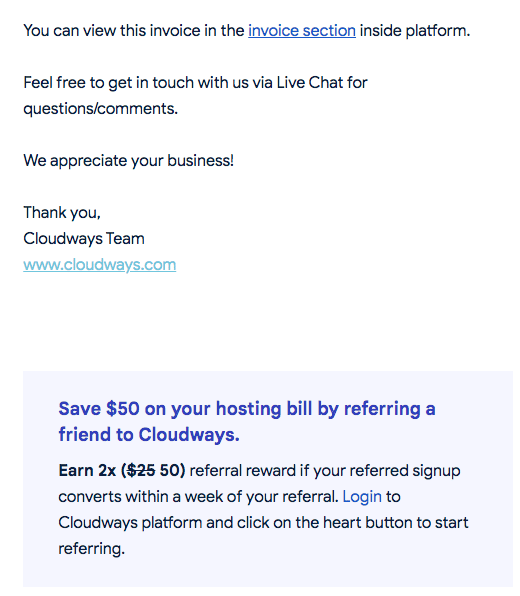
Source: Cloudways
To get this offer, the customer has to refer someone who converts within a week. This is an example of a company really making the most out of a transaction email.
Something as simple as an order confirmation email is turned into an opportunity to earn them a new customer.
Plus, by offering a deal, they’re also improving a relationship with an existing one.
Here’s another example of using transactional emails to promote offers.
BestSelf Co uses its order confirmation email to offer customers a gift—five days of free access to an online course:
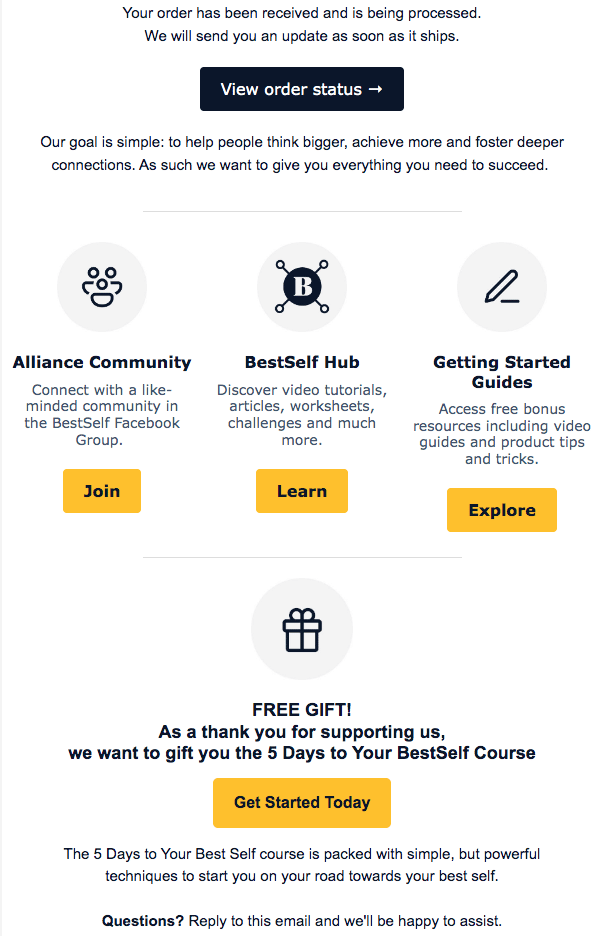
Source: BestSelf Co
If the CTA works and a recipient takes the course, there’s a high likelihood that the customer will feel closer to the company by the end of it.
Of course, it can be a hassle to send these emails out manually for every transaction, so many businesses use tools like Regpack that come with automated communication systems.
That way, you can set your system up so that whenever someone signs up for a subscription, buys a product, or does any action requiring a transaction email, your software automatically sends them the welcome email you’ve designed, and personalizes it as well.
For example, here’s someone setting up the conditions for when an email is sent:
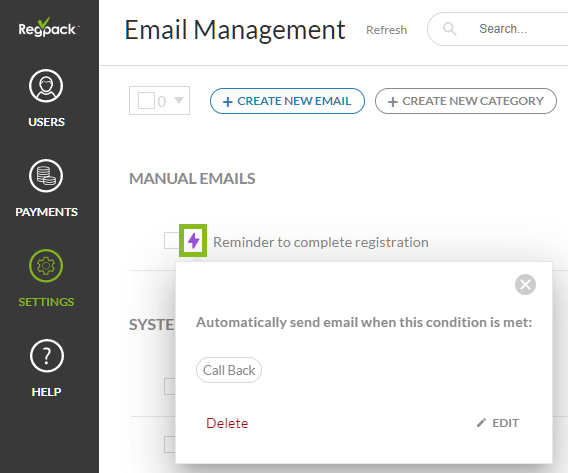
Source: Regpack
Really, the only type of transactional email that shouldn’t include promotional material is the technical email.
Those are emails that require the customer to take specific steps to solve an issue. No one wants to review offers while they’re trying to reset their password.
In sum, use your transactional emails to inform customers about your best offerings, as doing so can earn you more customer loyalty and business revenue.
Retarget Your Customers
Transactional emails can also be used to retarget customers who are undecided about making a certain purchase. Use the emails to give them a slight nudge.
Cart abandonment emails are a great example of transactional emails that retarget.
These are sent when a customer puts an item in their online shopping cart but doesn’t follow through with the purchase.
In these emails, you can remind the buyer about their potential purchase and offer them a discount to sweeten the deal.
With a 10.7% conversion rate, cart abandonment emails are a must-have in your email marketing strategy.
They also boast great open and click-through rates, according to Moosend’s data:
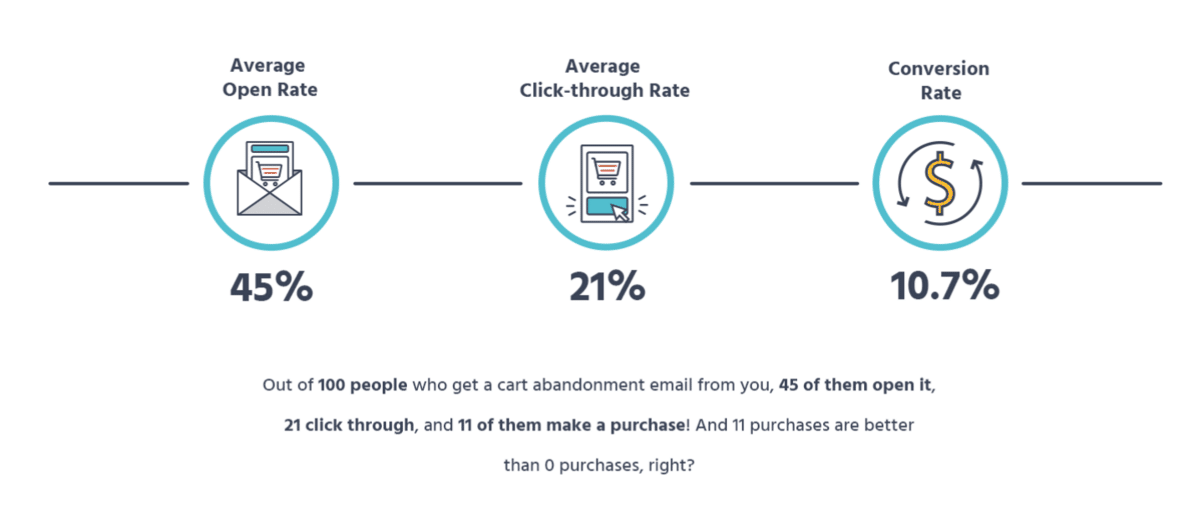
Source: Moosend
The online course platform edX uses this retargeting strategy well.
They send an email reviewing the item in the cart and offering a 10% discount in hopes the customer will remember how much they wanted the course and choose to complete the purchase.
Here’s their cart abandonment email:
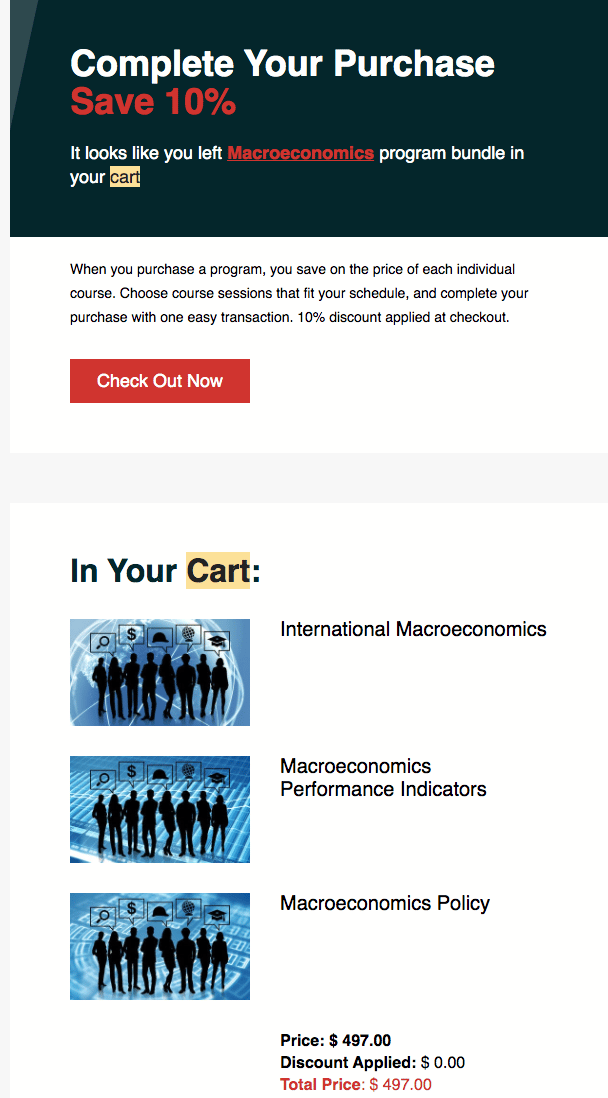
Source: edX
They also include a red CTA button with the words “Check Out Now” that gives the customer an easy way to get back onto the online store and into their cart to finish the purchase.
Another thing you could offer in the cart abandonment email is free shipping for the product. This cost reduction might be the little push they need to go through with it.
Keep in mind that retargeting isn’t limited to cart abandonment emails.
You could also use other types of transactional emails, like order confirmation emails, to remind customers of other products or services that were at one time in their cart but never purchased.
Or, if the customer was looking at other products on your website and purchased another product, you could include links to those browsed products in the order confirmation email.
The same goes for products the customer put on their wishlist but not in their cart.
For example, if a customer had a belt on their wishlist, you could show a linked picture of it in the payment acknowledgment email for a dress they just bought.
To summarize, retargeting customers in transactional emails is an extremely effective strategy for reviving sales opportunities that would have otherwise been lost forever.
Secure Further Sales
Use transactional emails, such as order confirmations or shipping updates, to secure further sales from a customer who has already made a purchase.
This is typically done by cross-selling and upselling.
These emails represent an ideal chance to market other products and services because customers are more likely to open them than non-transactional emails:

Source: Medium
For an example of cross-selling, you might recommend products that are complementary to the product they purchased.
If someone bought a pair of leather boots, they’d certainly appreciate a recommendation for leather polish from your brand in their order confirmation email.
To cross-sell in transactional emails, include the link to the offer, a description, the price, and a photo of the solution below the order confirmation details.
If you want to push the sale, you could offer the product at a discount too.
Another way to cross-sell is to show products or services that are similar to the product the recipient already purchased.
If a customer bought tickets to a tropical bird-watching tour, why not use the confirmation email to let them know about your brand’s seaside bird-watching tour as well?
For a real-world example, Thriftbooks uses its order confirmation emails to recommend books the buyer might like based on the genres and topics of the books they just purchased:
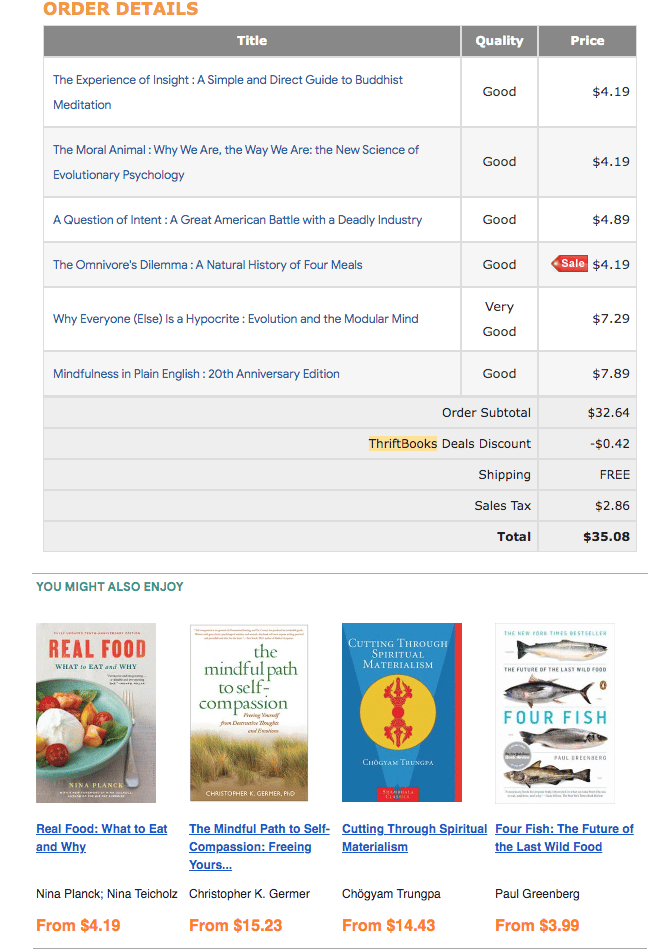
Source: Thriftbooks
56% of online shoppers say they are more likely to return to sites that offer personalized product recommendations, so this is an effective strategy for improving long-term customer loyalty as well as getting quick sales.
The other form of promotional selling based on recent purchases is upselling.
This is where you use the transactional email to try to get the customer to buy the higher-priced and upgraded version or subscription.
You’ll see this often in emails from SaaS businesses or any subscription-based companies.
For example, if you got a free trial of a project management tool, the company will likely use transactional emails to pitch the full version of the tool or the next tier up from free. Such a paid plan may be required to, say, manage multiple projects at once.
A business using HubSpot’s Starter plan might receive a description of the benefits of switching to the Professional plan in a “leave a review” email.
In conclusion, try to use welcome emails, confirmation emails, and even “leave a review” emails to encourage customers to buy products or services that might be a good fit for them.
Add Calls to Action
Calls to action (CTAs) come in various forms, from a link back to your website to a specially designed graphic or icon.
CTAs ask the customer to take some action that provides them value and helps your business at the same time:
| Download a helpful resource. |
| Enroll in a free course you’re offering. |
| Head back to your website to keep shopping. |
| Subscribe to your newsletter. |
| Share their experience on social media. |
| Refer a friend. |
There are so many options for CTAs, and they work in pretty much every transactional email, except for the most technical ones.
Therefore, it’s a good idea to include at least one visible CTA after the main content of the transactional email.
That way, you encourage the customer to take some next steps with your brand, thereby improving brand engagement and opening opportunities for future sales.
For example, you could include a CTA in shipping confirmation emails, and it could offer the customer a discount if they refer their friends to the company’s website.
Most emails use a CTA button that is linked to some part of the company’s website, like a product page or a free ebook.
Around the button might be sales language written to get customers excited about clicking the button. The button itself should tell the customer what will happen when they click it.
Common phrases are:
- “download the [resource]”
- “start your free trial”
- “get [discount] off”
- “shop now”
HubSpot does a good job of using multiple CTAs in their “download” transactional emails:
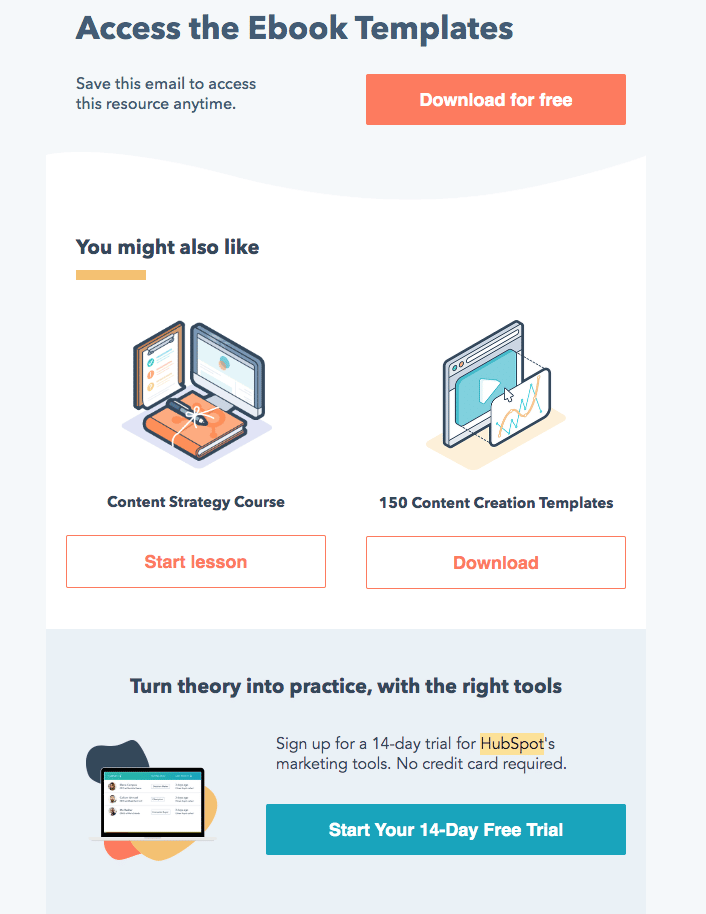
Source: HubSpot
The first CTA is for the ebook templates that the customer asked for. It’s important to put this first, as the customer is expecting it.
If, instead, the customer saw the free trial offer first, they’d be annoyed because they asked for access to templates, not a trial.
Below the ebook templates are two other helpful resources: a free lesson and an option to download more templates.
Lastly, HubSpot includes a CTA for a free 14-day trial in an effort to win some new users. Note how HubSpot states that no credit card is required.
This means less work and commitment on the side of the customer, so they’re more likely to take the CTA.
As a rule of thumb, try not to let the CTA design and messaging take up more than 20% of the email. Remember to keep the main focus of the transactional email intact.
Conclusion
Payment acknowledgment emails, shipping updates, and other transactional emails are great opportunities to encourage your customers to take some action that helps them and your business.
For instance, you can ask them to refer a friend, use a discount, or buy another product from your store. There’s a bounty of options.
That said, keep in mind that transactional emails should first cover their main purpose.
An order confirmation email must inform the customer that the business has received their order before it promotes a limited-time offer.
If you follow that rule, your customers will think of your promotions and requests as thoughtful recommendations instead of needy and tactless sales pitches.


















